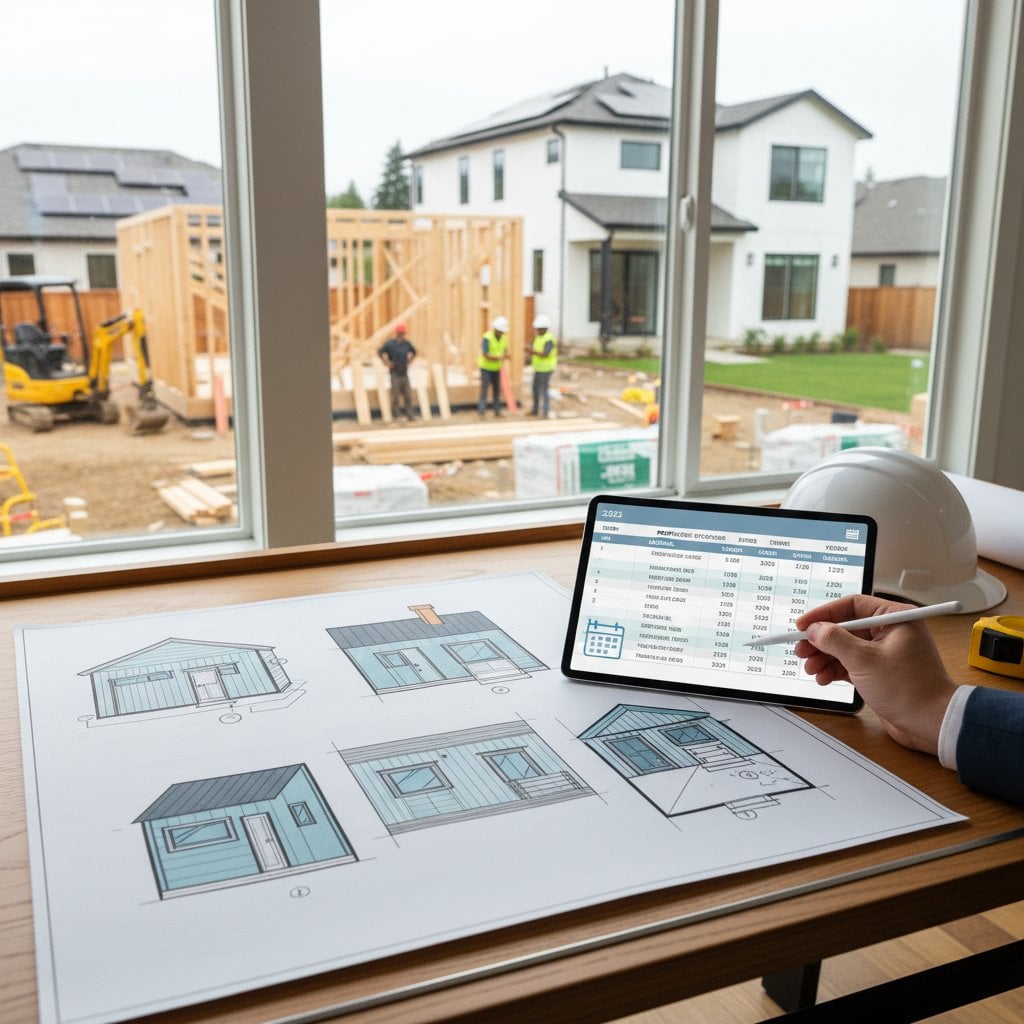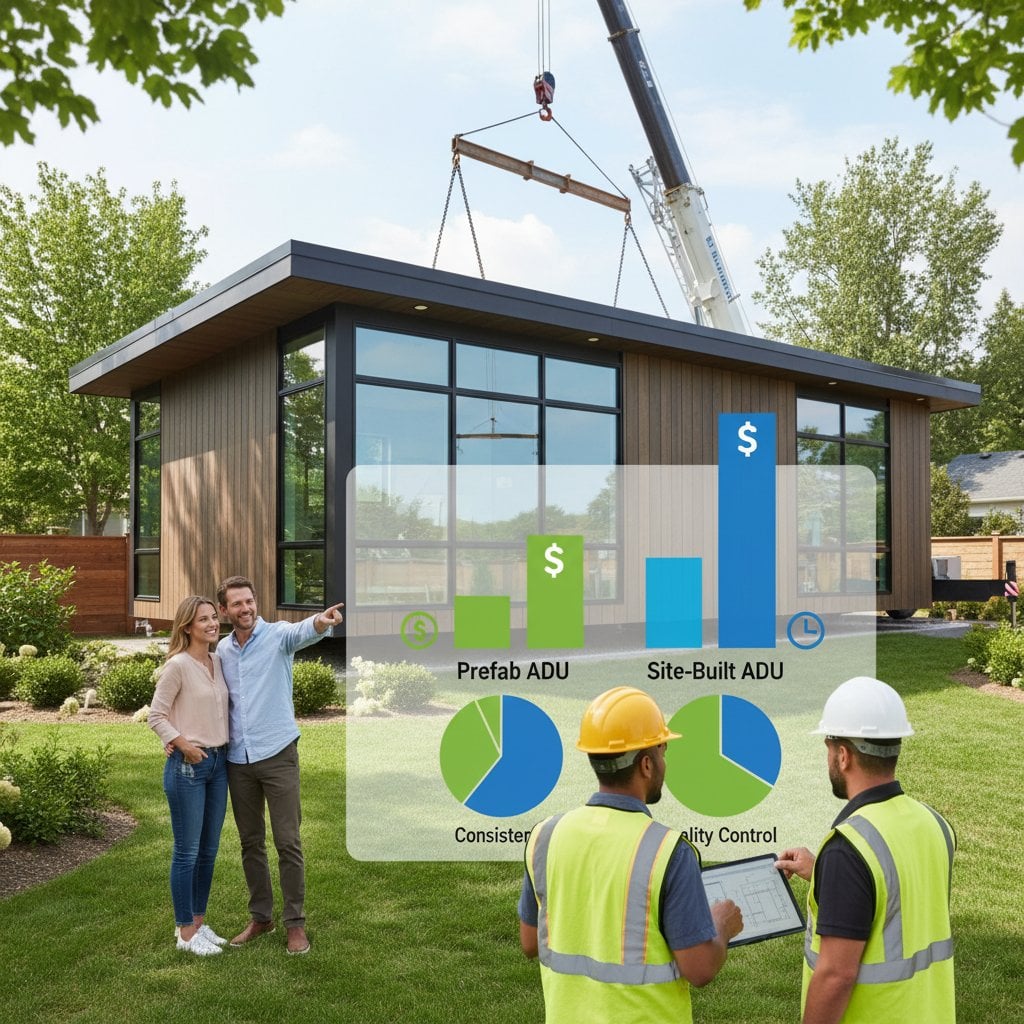Why Prefab ADUs Beat Site-Built in 2025 Budgets
Prefab accessory dwelling units, or ADUs, have become the smart choice for homeowners seeking affordable and efficient housing solutions. This guide explains why prefab ADUs outperform traditional site-built options in cost, construction time, and long-term value.
Quick Overview
Prefab ADUs are factory-built housing units delivered and installed on your property. They cost less, finish faster, and maintain consistent quality compared to structures built entirely on-site.
Cost and Time Estimates
Average cost range:
- Prefab ADU: $160,000 to $240,000 (including installation, site prep, and hookups)
- Site-built ADU: $240,000 to $350,000
Primary cost factors:
- Size: Larger units require more materials and labor.
- Foundation type: Slab or pier foundations affect excavation and concrete costs.
- Utility connections: Sewer, water, and electrical tie-ins vary by property.
- Permits and fees: Local regulations can add several thousand dollars.
Typical timelines:
- Prefab ADU: 3 to 5 months from order to occupancy.
- Site-built ADU: 8 to 12 months depending on weather, labor availability, and inspections.
Difficulty rating: Moderate. Prefab ADUs reduce many construction risks but still require coordination with local utility and permitting agencies.
DIY vs Professional Guidance
Prefab ADUs arrive mostly complete, but installation still requires experienced hands.
When you can handle tasks yourself:
- Site clearing, landscaping, or minor grading.
- Light interior finishes after installation, such as painting or flooring.
When to hire professionals:
- Utility connections, electrical tie-ins, and plumbing.
- Foundation work and crane placement.
- Permit applications and code inspections.
Cost comparison:
Hiring a licensed contractor for full prefab installation may add $20,000 to $40,000 to the total project, but it ensures compliance and warranty protection.
Step-by-Step Process for a Prefab ADU
- Property evaluation
- Verify zoning, setbacks, and utility access.
- Success check: The site meets local ADU regulations before ordering.
- Design selection
- Choose a unit size and floor plan that fits your lot and needs.
- Success check: The plan matches setback and height limits.
- Permit application
- Submit plans, site drawings, and engineering details to your city or county.
- Success check: Permit approved before construction begins.
- Site preparation
- Level the ground and install a foundation pad or pier system.
- Success check: Foundation is level and cured before delivery.
- Factory construction
- The manufacturer builds the ADU indoors under controlled conditions.
- Success check: The unit passes factory quality inspections.
- Delivery and installation
- A crane or trailer sets the structure on the prepared foundation.
- Success check: The unit sits level and secure before utilities connect.
- Utility hook-ups and inspection
- Licensed trades connect water, sewer, and power.
- Success check: All systems pass local inspection and function properly.
- Final finishes and occupancy
- Complete any trim, paint, or landscaping.
- Success check: The ADU is clean, safe, and ready for use.
Safety Warnings and Tips
Warning: Electrical Hazard
Never attempt to wire the ADU yourself. Use a licensed electrician for all connections.
Caution: Crane Operation Risk
Stay clear of lifting zones during delivery. Only trained operators should guide placement.
Protective gear:
Use gloves, boots, and safety glasses during site prep and cleanup. Keep the area clear of debris to prevent trips and falls.
Troubleshooting and Quality Checks
Common issues:
- Uneven foundation: Recheck level before anchoring the unit.
- Utility leaks: Pressure test plumbing lines before closing walls.
- Moisture around base: Confirm proper drainage away from the foundation.
Quality checks:
- Doors and windows open smoothly.
- Outlets and switches function on first inspection.
- Foundation bolts and anchors meet code requirements.
Cleanup and Disposal
Remove packaging material, pallets, and debris after installation.
- Recycle wood and metal materials where local facilities allow.
- Dispose of non-recyclable waste through approved construction dumpsters.
- Restore disturbed soil with topsoil and reseed grass if needed.
Maintenance and Lifespan
Prefab ADUs use factory-engineered materials that resist moisture and warping.
- Inspect annually: Roof seams, siding joints, and caulking.
- Clean gutters twice a year: Prevent overflow and siding damage.
- HVAC service: Schedule maintenance each season for efficiency.
A well-maintained prefab ADU can last 40 to 60 years with standard upkeep, similar to a conventional home.
When to Call a Professional
Call a licensed contractor if:
- The ADU requires a new foundation or retaining wall.
- You need trenching for deep utility runs.
- Your property has slope, drainage, or access challenges.
Hiring cost range:
A full-service contractor typically charges $25,000 to $50,000 for site work, installation, and coordination.
Checklist for choosing a contractor:
- State license with good standing.
- Proof of liability and workers’ compensation insurance.
- Written warranty on workmanship.
- References from completed ADU projects.
Pro Tips for Success
- Order early to secure manufacturing slots and avoid seasonal backlogs.
- Review local ADU ordinances before finalizing layout or size.
- Keep a dedicated project folder for permits, inspections, and warranties.
- Schedule inspections promptly to avoid delays in occupancy.
- Invest in quality finishes that balance cost and durability.
Prefab ADUs offer predictable budgets, faster completion, and fewer weather-related risks. By understanding each step, preparing your site correctly, and hiring qualified help when needed, you can create a durable, cost-effective living space that adds long-term value to your property.










